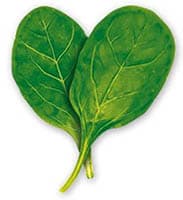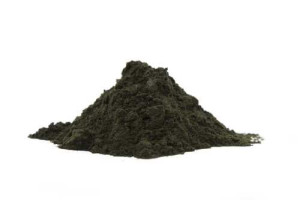Spinach Booster
NEWS: This superfood is now available in the SANEStore as a convenient whole-food powder so you can more easily enjoy it in smoothies and recipes.

Spinach contains a plethora of nutritional and medicinal properties which help to strengthen our immune system, boost energy levels, and provide our bodies with necessary vitamins and minerals. Spinach is a good source of Lutein, Protein, Iron, Fiber, Vitamin C, Vitamin A, Vitamin C, Vitamin K, Sodium, Manganese, Calcium, Phosphorus, Sodium, Beta-carotene, Potassium, Thiamine, Riboflavin, Carotenoids, Niacin, Chlorophyll, Antioxidants, Phytochemicals, Lipoic acid, and folate (also known as vitamin B9 and natural folic acid).
The A and C vitamins in spinach plus the fiber, folate, magnesium and other nutrients show promise against certain cancers, especially colon, lung and breast cancers. Folate also lowers the blood levels of homocysteine, a protein that damages arteries. So spinach also helps protect against heart disease. The flavonoids in spinach help protect against age related memory loss.
Spinach’s secret weapon, lutein, makes it one of the best foods in the world to combat cataracts, as well as age related macular degeneration is the leading cause of preventable blindness in the elderly. Spinach is truly a wonderful food; one which should not be overlooked.
Why Try Spinach Booster Superfood?
- Supporting the cardiovascular system
- Balancing blood sugar levels
- Combating asthma & allergies
- Supporting healthy circulation
- Aiding lung function
- Promoting joint health
- Improving skin
- Cleansing the liver
- Combating inflammation throughout the body
- Supporting good digestion
- Combating anemia
- Supporting a healthy heart
- Detoxifying & cleansing the colon
- Nourishing the brain & combating age-related cognitive problems
- Improving eye health & combating age related macular degeneration
References
1. Douglas Harper, Online Etymological Dictionary s.v. spinach. (WWW: Accessed 03/07/2010).
2. “spinach”. Oxford English Dictionary (3rd ed.). Oxford University Press. September 2005.
3. Victor R. Boswell, “Garden Peas and Spinach from the Middle East”. Reprint of “Our Vegetable Travelers” National Geographic Magazine, Vol 96:2 (Aug 1949). (WWW: Aggie Horticulture. Accessed 03/07/2010). Aggie Horticulture
4. Clifford A. Wright. Mediterranean Vegetables: A Cook’s ABC of Vegetables and their Preparation in Spain, France, Italy, Greece, Turkey, the Middle East, and North Africa, with More than 200 Authentic Recipes for the Home Cook. (Boston: Harvard Common Press, 2001). pp. 300-301.
5. Jacques Rolland and Carol Sherman, “Spinach”. The Food Encyclopedia: Over 8,000 Ingredients, Tools, Techniques and People . Toronto: Robert Rose. 2006. (WWW: Canadian Living. Accessed 03/07/2010).
6. Spinach, The George Mateljan Foundation
7. Margaret Grieve; Maud Grieve (1 June 1971). A modern herbal: the medicinal, culinary, cosmetic and economic properties, cultivation and folk-lore of herbs, grasses, fungi, shrubs, & trees with all their modern scientific uses. Courier Dover Publications. pp. 761–. ISBN 978-0-486-22799-3. Retrieved 13 August 2010.
8. G. F. M. Ball (2006). Vitamins in foods: analysis, bioavailability, and stability. CRC Press. pp. 236–. ISBN 978-1-57444-804-7. Retrieved 13 August 2010.
9. Gideon Koren (2007). Medication safety in pregnancy and breastfeeding. McGraw-Hill Professional. pp. 279–. ISBN 978-0-07-144828-4. Retrieved 13 August 2010.
10. U.S. Department of Agriculture, Agricultural Research Service. 2005. USDA National Nutrient Database for Standard Reference, Release 18. Nutrient Data Laboratory Home Page, http://www.nal.usda.gov/fnic/foodcomp
11. http://helios.hampshire.edu/~nlNS/mompdfs/oxalicacid.pdf
12. Williams, Sue Rodwell; Long, Sara (1997). Nutrition and diet therapy. p. 229. ISBN 978-0-8151-9273-2.
13. http://jn.nutrition.org/cgi/reprint/114/3/526.pdf
14. Insel, By Paul M.; Elaine Turner, R.; Ross, Don (2003). Nutrition. p. 474. ISBN [[Special:BookSources/978076370765|978076370765[[Category:Articles with invalid ISBNs]]]] Check |isbn= value (help). Retrieved 2009-04-15.
15. Heaney, Robert Proulx (2006). Calcium in human health. p. 135. ISBN 978-1-59259-961-5. Retrieved 2009-04-15.
16. “Storage Time And Temperature Effects Nutrients In Spinach”. Retrieved 2008-07-05.
17. “Production of Spinach by countries”. UN Food & Agriculture Organization. 2011. Retrieved 2013-08-26.
18. Nutrient Retention of Safer Salads Explored | Environmental Working Group
19. Gabbatt, Adam (8 December 2009). “E.C. Segar, Popeye’s creator, celebrated with a Google doodle”. guardian.co.uk. Retrieved 5 May 2010.
20. Fullerton-Smith, Jill (2007). The Truth about Food. Bloomsbury Publishing. p. 224. Retrieved February 18, 2012.
21. “SPINACH, IRON and POPEYE: Ironic lessons from biochemistry and history on the importance of healthy eating, healthy scepticism and adequate citation”. Internet Journal of Criminology.
22. Karl Kruszelnicki (6 December 2011). “Popeye’s spinach story rich in irony”. Australian Broadcasting Corporation.
24. Asai A, Terasaki M, Nagao A. An epoxide-furanoid rearrangement of spinach neoxanthin occurs in the gastrointestinal tract of mice and in vitro: formation and cytostatic activity of neochrome stereoisomers. J Nutr. 2004 Sep;134(9):2237-43. 2004. PMID:15333710.
25. Asai A, Yonekura L and Nagao A. Low bioavailability of dietary epoxyxanthophylls in humans. Br J Nutr. 2008 Aug;100(2):273-277. 2008.
26. Chung HY, Rasmussen HM, Johnson EJ. Lutein bioavailability is higher from lutein-enriched eggs than from supplements and spinach in men. J Nutr. 2004 Aug;134(8):1887-93. 2004. PMID:15284371.
27. Edenharder R, Keller G, Platt KL, Unger KK. Isolation and characterization of structurally novel antimutagenic flavonoids from spinach (Spinacia oleracea). J Agric Food Chem 2001 Jun;49(6):2767-73. 2001. PMID:12950.
28. Gates MA, Tworoger SS, Hecht JL, De Vivo I, Rosner B, Hankinson SE. A prospective study of dietary flavonoid intake and incidence of epithelial ovarian cancer. Int J Cancer. 2007 Apr 30; [Epub ahead of print]. 2007. PMID:17471564.
29. genannt Bonsmann SS, Walczyk T, Renggli S et al. Oxalic acid does not influence nonhaem iron absorption in humans: a comparison of kale and spinach meals. Eur J Clin Nutr. 2008 Mar;62(3):336-41. Epub 2007 Apr 18. 2008.
30. Longnecker MP, Newcomb PA, Mittendorf R, et al. Intake of carrots, spinach, and supplements containing vitamin A in relation to risk of breast cancer. Cancer Epidemiol Biomarkers Prev 1997 Nov;6(11):887-92. 1997. PMID:12980.
31. Lucarini M, Lanzi S, D’Evoli L et al. Intake of vitamin A and carotenoids from the Italian population–results of an Italian total diet study. Int J Vitam Nutr Res. 2006 May;76(3):103-9. 2006.
32. Makiko I, Mutsuko T, and Takashi N. Influence of the Amount of Boiling Water on the Sensory Evaluation, Oxalic Acid and Potassium Content of Boiled Spinach. Journal of Cookery Science of Japan 2005, 38(4):343-349. 2005.
33. Manach C, Scalbert A, Morand C, Rémésy C, Jiménez L. Polyphenols: food sources and bioavailability. Am J Clin Nutr. 2004 May;79(5):727-47. 2004. PMID:15113710.
34. Morris MC, Evans DA, Tangney CC, Bienias JL, Wilson RS. Associations of vegetable and fruit consumption with age-related cognitive change. Neurology. 2006 Oct 24;67(8):1370-6. 2006. PMID:17060562.
35. Okazaki K, Oka N, Shinano T et al. Differences in the metabolite profiles of spinach (Spinacia oleracea L.) leaf in different concentrations of nitrate in the culture solution. Plant Cell Physio. 2008 Feb;49(2):170-7. Epub 2007 Dec 17. 2008.
36. Song W, Derito CM, Liu MK et al. Cellular antioxidant activity of common vegetables. J Agric Food Chem. 2010 Jun 9;58(11):6621-9. 2010.
37. Tang G, Qin J, Dolnikowski GG et al. Spinach or carrots can supply significant amounts of vitamin A as assessed by feeding with intrinsically deuterated vegetables. Am J Clin Nutr. 2005 Oct;82(4):821-8. 2005.
38. Wang Y, Chang CF, Chou J, Chen HL, Deng X, Harvey BK, Cadet JL, Bickford PC. Dietary supplementation with blueberries, spinach, or spirulina reduces ischemic brain damage. Exp Neurol. 2005 May;193(1):75-84. 2005. PMID:15817266.
39. Yang Y, Marczak ED, Yokoo M, Usui H, Yoshikawa M. Isolation and antihypertensive effect of angiotensin I-converting enzyme (ACE) inhibitory peptides from spinach Rubisco. J Agric Food Chem. Aug 13;51(17):4897-902. 2003.









